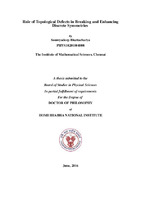- DSpace Home
- →
- IMSc Theses/ Dissertations
- →
- IMSc Theses/ Dissertations
- →
- View Item
JavaScript is disabled for your browser. Some features of this site may not work without it.
| dc.contributor.author | Soumyadeep Bhattacharya | |
| dc.date.accessioned | 2017-05-16T05:59:42Z | |
| dc.date.available | 2017-05-16T05:59:42Z | |
| dc.date.issued | 2016 | |
| dc.date.submitted | 2016 | |
| dc.identifier.uri | https://dspace.imsc.res.in/xmlui/handle/123456789/398 | |
| dc.description.abstract | Phase transitions accompanied by spontaneous breaking of continuous symmetries have been studied extensively in condensed matter and high energy physics. In this thesis we investigate the spontaneous breaking of discrete symmetries, specifically in spin models with three-fold, four-fold and higher discrete symmetries. We show that an interplay between the topological defects - domain walls and vortices - in these models drives the discrete symmetry to be completely broken, partially broken and even enhanced to a continuous U(1) symmetry. We show that in two dimensions, percolation of domain walls drives a transition from a symmetry broken ordered phase to a symmetry enhanced quasi long range ordered phase which, in turn, undergoes a transition to the symmetry restored disordered phase when vortices proliferate. We highlight a flaw in the standard method for calculating winding numbers and propose a new method which correctly identifies vortices. We show that suppression of vortices in models with even number of states leads to an intermediate partially ordered phase and that additional suppression of domain walls, separating opposite spin states, is required to manifest the symmetry enhanced phase. We show that spin models with three or higher number of states exhibit a partial symmetry broken phase instead of symmetry enhanced phase in three dimensions as individual types of domain walls are able to percolate on their own. We also obtain a variety of phases by suppressing defects belonging to subgroups of the model’s symmetry. Upon enhancing the formation of vortices instead of suppressing them, we obtain a vortex-antivortex lattice phase in two dimensions and a vortex condensate phase in three dimensions. | en_US |
| dc.publisher.publisher | The Institute of Mathematical Sciences | |
| dc.subject | Topological Defects | en_US |
| dc.subject | Discrete Symmetries | en_US |
| dc.subject | Phase Transitions | en_US |
| dc.subject | HBNI Th111 | en_US |
| dc.title | Role of topological defects in breaking and enhancing discrete symmetries[HBNI Th111] | en_US |
| dc.type.degree | Ph.D | en_US |
| dc.type.institution | HBNI | en_US |
| dc.description.advisor | Purusattam Ray | |
| dc.description.pages | 178p. | en_US |
| dc.type.mainsub | Physics | en_US |
| dc.type.hbnibos | Physical Sciences |
Files in this item
This item appears in the following Collection(s)
-
IMSc Theses/ Dissertations
IMSc Theses/ Dissertations
